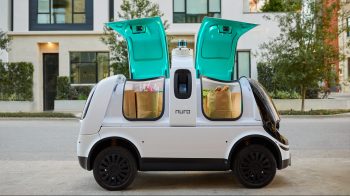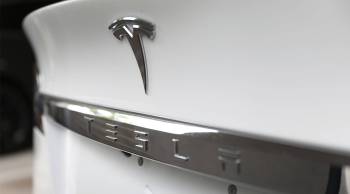
How advanced are China’s self-driving taxis?

In Wuhan city, in the central Chinese province of Hubei, self-driving electric cars with sensing equipment strapped on the roof are becoming more of a common sight. Some local residents stop to take photos. Others, like taxi driver Xiao Weiguo, feel apprehensive.
He has been driving a taxi for 14 years and said he spots a robot taxi every day on his shift.
“I would keep my distance from robot taxis, because they will stop if there is an obstacle or a pedestrian in front of them. In rush hour, they can cause traffic jams. Its technology is not that mature,” Xiao said.
Autonomous cars remain largely experimental globally. However, Chinese firms, with the support of China’s government at various levels, are speeding up testing of the technology. Tesla is also eager to get in the game, and said it aims to offer its full self-driving technology early next year in China, pending regulatory approval from Chinese officials. The firm has reportedly floated the idea of deploying this technology first in taxis in China, but it will face some fierce domestic competition by the time it enters the market.

There are 16 cities in China testing robot taxis. Of those, Beijing and Wuhan have the most advanced pilot projects. In most Chinese cities, self-driving vehicles are mainly confined to a small, suburban area, and they usually come with a human driver for safety.
Wuhan is the first city in China to allow mostly unmanned robot taxis to operate in a much bigger area — about 1,160 square miles or one-third of the city — including a part of its downtown.
Chinese tech giant Baidu has the biggest fleet of robot taxis — about 400 — in Wuhan. That is a tiny number compared to the tens of thousands of regular taxis and rideshare cars in a city of 13.8 million people.
Still, it raises a lot of anxiety for taxi drivers like Xiao who are already struggling to compete against rideshare apps, which offer a lot of discounts. They say self-driving taxis add to an already crowded industry.
“Once lots of robot taxis go on the market, people like me will lose our jobs,” Xiao said.
But Ling Zhijun, a rideshare driver from Beijing, is more optimistic about his future.
He thinks the layout and complexity of driving in Beijing could limit the role of robot taxis. The city’s downtown has many narrow lanes filled with bicycles and people zigzagging.
“Robot taxis stop when there is a pedestrian and cause traffic jams,” Ling said. “Robot taxis would not be able to drive in the center of Beijing. They would get stuck in the alleys.”

However, Beijing’s pilot is not just focused on autonomous vehicles. Even the road intersections are equipped with cameras and sensors to help the self-driving vehicles navigate better.
“China is one of the only, if not the only country, that has really made this [integrative] approach one of its core aspects [in the development of self-driving technology],” said Andrew Stokols, a lecturer in urban planning at Massachusetts Institute of Technology.
In Beijing, there are nearly 900 autonomous vehicles, which include taxis, delivery vehicles and buses. The local government has attracted tech giant Baidu, startups WeRide and Pony.ai, and e-commerce giant JD.com to test their self-driving technology on the city’s outskirts in the Yizhuang area.
Stokols researched the pilot zone in Beijing this past summer after talking to tech experts, urban designers and testing self-driving taxis.

He said Beijing’s approach to integrating autonomous taxis and road infrastructure has some safety benefits. For example, if an 18-wheeler truck blocks a robot taxi’s view of an intersection, then the cameras at the intersection will see the oncoming traffic around that obstruction.
“[The cameras] would be able to alert the car earlier as it’s approaching the intersection, and it would be able to slow down or brake more smoothly,” he said.
However, he said the Beijing pilot would be hard to scale, in part because of the cost of updating road intersections. In 2022, Beijing reportedly installed cameras and sensors in only about 300 road intersections, but there has been no update since.

Also, the process of ordering a robot taxi, be it in Beijing or Wuhan, is not smooth yet. It can take 30 minutes before a passenger is assigned a car. Plus, there are designated pick-up points that are sometimes few and far between.
“Marketplace” had to take cars driven by humans to get to the robot taxi pickup spots. At least one driver said he would not hop in a self-driving taxi because he did not want to risk his life. China’s government actively promotes the autonomous vehicle industry, but it hasn’t published data on safety incidents involving self-driving cars.

However, cab driver Xiao agreed to test a robot taxi with “Marketplace” in Wuhan. Once inside an unmanned cab, he was excited and called his friend on the phone.
“Look,” he said in a video call to a fellow cab driver, “the robot taxi is going pretty fast, even a bit above the speed limit.”
But Xiao was less impressed with the robot taxi’s road skills when there was more traffic. The car slowed down. Impatient cars with human drivers behind would speed up, causing the robot taxi to hesitate when changing lanes or brake suddenly.
“See, the car just stopped. If this was during morning rush hour, and it stopped like this, that would cause a traffic jam,” he said.

We arrived at our destination 37 minutes later and paid 36.6 yuan, or $5.
However, without Baidu’s deep discounts, the trip would’ve cost 102 yuan, or $14, which is a lot more than what a ride in Xiao’s taxi would cost. He said the self-driving technology is more advanced than he initially thought. But it was not as smooth a ride.
“The robot taxi doesn’t change lanes very smoothly. So, it can make passengers feel sick,” he said.
However, Xiao said, self-driving technology keeps improving. He just hopes he can keep driving his regular cab until he retires in a few more years.
Additional research by Charles Zhang.
There’s a lot happening in the world. Through it all, Marketplace is here for you.
You rely on Marketplace to break down the world’s events and tell you how it affects you in a fact-based, approachable way. We rely on your financial support to keep making that possible.
Your donation today powers the independent journalism that you rely on. For just $5/month, you can help sustain Marketplace so we can keep reporting on the things that matter to you.

















